°F
°F
mph
Windspeed
%
Humidity











Montville, Ohio is a small town located in Geauga County, in the northeastern part of the state. The climate in Montville is classified as humid continental, characterized by four distinct seasons. Summers are typically warm and humid, with average temperatures ranging from the mid-70s to low 80s Fahrenheit, while winters tend to be cold and snowy, with average temperatures in the 20s and 30s Fahrenheit.
Montville is blessed with abundant water resources, with several rivers, streams, and lakes in the surrounding area. The hydrology constituents of Montville include the Grand River, which flows through the town, providing opportunities for fishing and boating enthusiasts. Additionally, there are numerous smaller streams and creeks that offer picturesque settings for outdoor activities like kayaking and canoeing.
Outdoor recreation opportunities in Montville are plentiful. The town is surrounded by beautiful natural landscapes, including forests and parks that are perfect for hiking, camping, and picnicking. The nearby Punderson State Park is a popular destination for outdoor enthusiasts, offering activities such as swimming, boating, fishing, and golfing. Montville is also home to several nature reserves and wildlife areas, providing opportunities for birdwatching and wildlife viewing.
In conclusion, Montville, Ohio offers a varied climate with distinct seasons, abundant water resources, and a range of outdoor recreation opportunities, making it an attractive destination for nature lovers and outdoor enthusiasts.
Weather Forecast
Montville receives approximately 1205mm of rain per year, with humidity levels near 80% and air temperatures averaging around 9°C. Montville has a plant hardyness factor of 5, meaning plants and agriculture in this region thrive during a short period during spring and early summer. Most plants will die off during the colder winter months.
Regional Streamflow Levels
1,010
Cubic Feet Per Second
281
Cubic Feet Per Second
1,610
Cubic Feet Per Second
17
Cubic Feet Per Second
Nearby Camping
| Camping Area | Reservations | Toilets | Showers |
|---|---|---|---|
| Mill Creek - Berlin Reservoir | |||
| Dalewood Conservation Area | |||
| Lake Whittaker Conservation Area | |||
| Springwater Conservation Area | |||
| Guilford Lake State Park | |||
| Petersburg Boat Landing |



